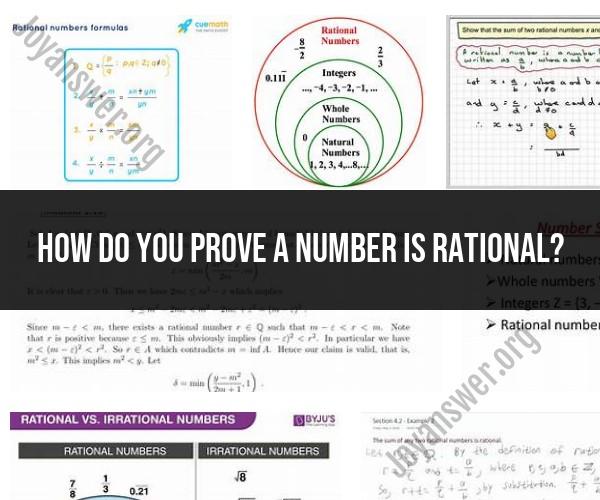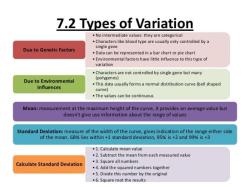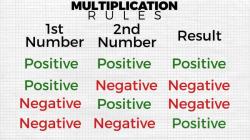How do you prove a number is rational?
To prove that a number is rational, you need to demonstrate that it can be expressed as a ratio of two integers, where the denominator is not zero. In other words, a rational number is any number that can be written in the form p/q, where p and q are integers, and q is not equal to zero. Here are several mathematical techniques to prove that a number is rational:
Direct Construction: The simplest way to prove a number is rational is to explicitly express it as a fraction. For example, if you can write a number like 0.75 as 3/4, you've proven that it's rational.
Common Factor: If you have a number expressed as a fraction, you can show that it is rational by demonstrating that the numerator and denominator have a common factor other than 1. For example, if you have 6/9, you can simplify it to 2/3, showing that it's rational.
Algebraic Manipulation: You can manipulate algebraic expressions to show that they are rational numbers. For instance, if you have the expression (2x + 3) / (4x - 6), you can simplify it to (2(x + 3)) / (4(x - 1)), which is clearly a ratio of integers.
Roots of Polynomials: If a number is a root of a polynomial equation with integer coefficients, it is rational. For example, if a number is a root of the polynomial equation x^2 - 5x + 6 = 0, it is rational because the coefficients (1, -5, 6) are integers.
Repeating or Terminating Decimals: If a decimal representation of a number either repeats or terminates, it is rational. For example, 0.666... (repeating 6s) is rational because it can be expressed as 2/3. Similarly, 0.25 (terminating) is rational because it can be expressed as 1/4.
Continued Fractions: You can represent a number as a continued fraction and show that it is rational. For example, √2 can be expressed as [1; 2, 2, 2, ...], which is a rational number.
Using Properties of Rational Numbers: Sometimes, you can prove that a number is rational by using properties of rational numbers, such as closure under addition, subtraction, multiplication, and division. For instance, if you have two rational numbers a and b and you find their sum a + b to be a rational number, then a - b and a * b will also be rational.
Contradiction: In some cases, you can prove a number is rational by assuming it's irrational and then arriving at a contradiction. This technique is used for numbers like √2. Suppose √2 is irrational, and then use that assumption to derive a contradiction, showing that it must be rational.
These are some of the common techniques for proving that a number is rational. The specific technique you use depends on the nature of the number and the problem you're trying to solve.
Proving the Rationality of a Number: Methods and Techniques
There are a number of different methods and techniques that can be used to prove that a number is rational. Some of the most common methods include:
- Direct proof: This method involves showing directly that the number can be expressed as the fraction of two integers. For example, to prove that the number 1/2 is rational, we can simply write it as the fraction 1/2, where the numerator and denominator are both integers.
- Proof by contradiction: This method involves assuming that the number is irrational and then showing that this leads to a contradiction. For example, to prove that the number √2 is irrational, we can assume that √2 is rational and then show that this leads to the contradiction that √2 is an integer.
- Proof by mathematical induction: This method involves proving a statement for a particular value and then showing that it is true for all subsequent values. For example, to prove that all terminating decimals are rational, we can prove that the decimal 0.1 is rational and then show that this implies that all subsequent terminating decimals are also rational.
Demonstrating Rationality: How to Prove a Number Is Rational
To prove that a number is rational, we need to show that it can be expressed as the fraction of two integers. We can do this using one of the methods described above.
For example, to prove that the number 1/2 is rational, we can simply write it as the fraction 1/2, where the numerator and denominator are both integers.
To prove that the number √2 is irrational, we can use the following proof by contradiction:
- Assume that √2 is rational. This means that √2 can be expressed as the fraction of two integers, p and q, where p and q have no common factors.
- Square both sides of this equation to get 2 = p^2/q^2.
- Multiply both sides of this equation by q^2 to get 2q^2 = p^2.
- This means that p^2 is even. Since the square of an odd number is always odd, this means that p must be even.
- Let p/2 = n. Substituting this into the equation 2q^2 = p^2, we get 2q^2 = 4n^2.
- Dividing both sides of this equation by 2, we get q^2 = 2n^2.
- This means that q^2 is even. Since the square of an odd number is always odd, this means that q must also be even.
- But this is a contradiction, because we assumed that p and q had no common factors.
- Therefore, our assumption must have been wrong, and √2 cannot be rational.
Mathematical Proof of Rational Numbers: Step-by-Step Guide
Here is a step-by-step guide to proving that a number is rational using the direct proof method:
- State the theorem that you want to prove. For example, you might want to prove the following theorem:
Theorem: All terminating decimals are rational numbers.
- Write down the proof. The proof should consist of a series of logical steps that lead to the conclusion of the theorem. For example, the following proof could be used to prove the theorem above:
Proof:
Let d be a terminating decimal. This means that d can be expressed in the form d = a/10^n, where a is an integer and n is a non-negative integer.
To show that d is rational, we need to show that it can be expressed as the fraction of two integers. We can do this by multiplying both sides of the equation d = a/10^n by 10^n. This gives us the equation 10^n * d = a.
Since 10^n is an integer, this means that 10^n * d is also an integer. This means that a is an integer, and therefore d is rational.
- Conclude the proof by stating the conclusion of the theorem. For example, the following conclusion could be used to conclude the proof above:
Conclusion:
Therefore, all terminating decimals are rational numbers.
This is just a basic example of how to prove that a number is rational. There are many other methods and techniques that can be used, depending on the specific number in question.












